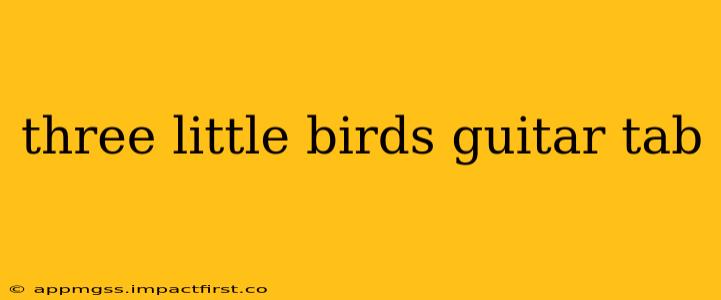Bob Marley's "Three Little Birds" is a timeless classic, instantly recognizable for its soothing melody and uplifting message. Learning to play it on guitar is a rewarding experience, accessible to both beginners and experienced players. This guide will explore various aspects of playing "Three Little Birds" on guitar, catering to different skill levels and offering resources for further learning.
Finding the Right Tablature
The internet is brimming with "Three Little Birds" guitar tabs, but quality varies significantly. Look for tabs that:
- Specify the tuning: Ensure the tab is written for standard tuning (E A D G B e) unless otherwise stated. Some versions might use alternate tunings.
- Include chords: Many tabs will display the chord diagrams alongside the fretting positions, making it easier to understand the song's structure.
- Offer different versions: Search for versions suited to your skill level – beginner, intermediate, or advanced. Simpler versions might omit some embellishments or use simpler strumming patterns.
- Come from reputable sources: Websites dedicated to guitar tabs, like Ultimate-Guitar.com, often have user-submitted and verified tabs, ensuring accuracy and quality.
Beginner Tip: Start with a simplified version. Don't get discouraged if you can't play the most complex arrangements initially. Focus on mastering the basic chords and strumming patterns first.
Mastering the Basic Chords
"Three Little Birds" primarily uses a few simple, common chords:
- G major: This is a fundamental chord in many songs.
- C major: Another essential chord, easy to transition to from G.
- D major: Adds a little more complexity but is still relatively straightforward.
Practice transitioning smoothly between these chords. The smoother your transitions, the more polished your rendition will sound. Use a metronome to develop consistent timing and rhythm.
How do I learn the finger positions for these chords?
Numerous online resources, including YouTube videos and interactive chord diagrams, can guide you through the correct finger placements for G, C, and D major chords. Many apps provide visual and audio feedback, assisting in learning and practicing. Focus on developing a comfortable and efficient finger placement to ensure clean and clear sound.
What are some helpful resources for learning guitar chords?
Beyond online videos and apps, consider enrolling in a guitar class or working with a private instructor for personalized guidance. These instructors can provide hands-on instruction and address specific challenges in your technique. Guitar learning books also offer comprehensive instruction and chord charts.
Understanding the Strumming Pattern
The strumming pattern in "Three Little Birds" is relatively straightforward, often employing a down-down-up-down-up rhythm. Experiment with variations in strumming speed and intensity to create different moods and dynamics. Listen carefully to Bob Marley's original recording to grasp the nuances of his strumming.
How can I improve my strumming technique?
Consistent practice is key. Start slowly, focusing on accuracy and rhythm. Gradually increase speed as your proficiency grows. Use a metronome to maintain tempo and develop a sense of timing. Experiment with different strumming patterns to discover what works best for you and the song.
Adding Your Personal Touch
Once you've mastered the basics, explore adding your own flair:
- Fingerpicking: Try incorporating fingerpicking techniques to create a more intricate and nuanced sound.
- Variations in strumming: Experiment with different rhythmic patterns to add interest.
- Adding embellishments: Learn some simple guitar riffs or melodies to embellish the song.
"Three Little Birds" is a fantastic song to learn on guitar, offering a satisfying journey from beginner chords to more expressive playing. Remember that consistency and patience are crucial – enjoy the process of learning and expressing yourself through music!
